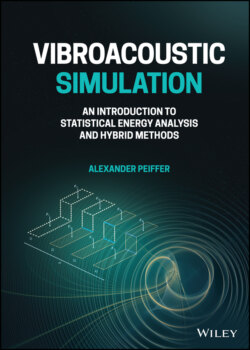Читать книгу Vibroacoustic Simulation - Alexander Peiffer - Страница 57
2.2.3 Equation of State
ОглавлениеThe above equations relate pressure, velocity and density. For further reducing this set we need a third equation. The easiest way would be to introduce the . Here we start with the first law of thermodynamics in order to show the difference between isotropic (or adiabatic) equation of state and other relationships.
(2.9)
With the following specific quantities per unit mass
(2.10)
With the specific entropy ds=dq+drT we get:
(2.10)
The relation dv=d(1/ρ) comes from the fact that v is a mass specific value and therefore the reciprocal of the density ρ=1/v. For an ideal gas we have
(2.11)
cp and cv are the specific thermal heat capacities for constant pressure and volume, respectively. That is the ratio of temperature change ∂T per increase of heat ∂q. From the total differential
(2.12)
we can derive
(2.13)
Using all above relations the change in density dρ is:
(2.14)
with κ=cv/cp. In most acoustic cases the process is isotropic: i.e. time scales are too short for heat exchange in a free gas; thus ds=0, and the change of pressure per density is
(2.15)
In case of constant temperature (isothermal) dT=0 we get with (2.12) and the ideal gas law (2.11):
(2.16)
As we will later see, c0 is the . Newton calculated the wrong speed of sound based on the assumption of constant temperature that was later corrected by Laplace by the conclusion that the process is adiabatic. For fluids and liquids like water a different quantity is used because there is no such expression as the ideal gas law. The bulk modulus is defined as:
(2.17)
Due to (2.15) and (2.16) the relationship between the bulk modulus K and c0 is:
(2.18)
The bulk modulus can be defined for gases too, but we must distinguish between isothermal or adiabatic processes.
(2.19)
